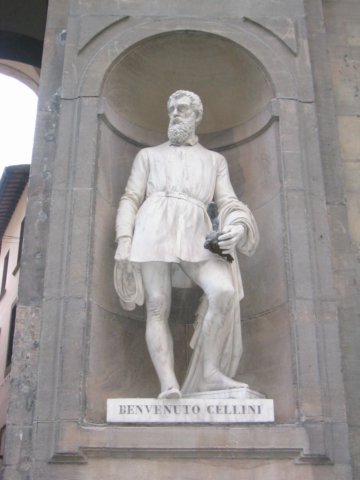 |
Benvenuto Cellini (1500-1571) |
Florentine sculptor and engraver, who became one of the foremost goldsmiths of the Italian Renaissance, executing exquisitely crafted coins, jewelry, vases, and ornaments. Born in Florence, on November 3, 1500, Cellini was apprenticed to a goldsmith at the age of 15. When he was 16, his fiery temper and continual dueling and brawling caused him to be exiled to Siena. Later, in Rome, he was Michelangelo's pupil for a short while. Among Cellini's most famous patrons were Pope Clement VII, Pope Paul III, Francis I of France, and the Florentine noble Cosimo I de' Medici. Francis I invited him to Paris in 1540, where he modeled the bronze reliefs of the Nymph of Fontainebleau (Louvre, Paris). He also executed an elaborate gold saltcellar for Francis (1539-43, Kunsthistorisches Museum, Vienna). Compelled to leave in 1545 because of his quarrels with the king's mistress and his eccentricities, Cellini returned to Florence. There, under the patronage of Cosimo de' Medici, he executed many fine works in metal, among them a bronze portrait bust of Cosimo and the colossal bronze statue Perseus and Medusa (1545-54, Loggia dei Lanzi, Florence). He died in Florence, on February 13, 1571. Cellini is also noted for his autobiography, written between 1558 and 1562, the standard English version of which was published in 1960. An embellished account of Cellini's escapades, adventures, and intrigues, this text provides a valuable portrait of daily, political, social, and ecclesiastical life in the 16th century. "Cellini, Benvenuto," Microsoft (R) Encarta. Copyright (c) 1994 Microsoft Corporation. Copyright (c) 1994 Funk & Wagnall's Corporation.
Created with Web Album Generator